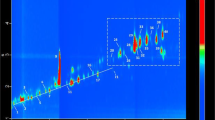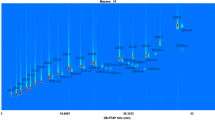Abstract
Introduction
Chromatography with mass spectrometry (MS) is a technique of choice for metabolomic analysis of plant extracts. Single dimension gas chromatography (1DGC) with MS leads to poorly resolved metabolites of complex Eucalyptus spp. leaf oil secondary metabolites and consequently limited metabolic coverage of secondary compounds. Multidimensional chromatography with high resolution MS can contribute to advances in this field.
Objectives
Deeper insight into metabolite composition and variation for Eucalyptus spp. leaf oils through systematic untargeted metabolic profiling using comprehensive two-dimensional GC (GC × GC) with high resolution time-of-flight MS (accTOFMS), using generalised processes for metabolite identification.
Methods
GC × GC separation used cryogenic modulation, with standard length polar first dimension and short fast analysis non-polar 2D columns. Compound tentative identification incorporated 1D and 2D retention information, retention indices, mass spectrum matching, and accurate mass MS data. Global metabolic profiles were interpreted through 2D contour plots and chemometric analysis.
Results
Strategies for metabolite screening and identification using GC × GC-accTOFMS were proposed. Considerably more components are detected and recognised than for 1DGC. Structured 2D molecular composition chromatographic patterns aid identification. ca. 400 metabolites were detected, 183 compounds were identified or tentatively identified, representing between 50.8–90.0% of the total ion count, comprising various chemical families. PCA revealed discriminating metabolites, allowing chemotaxonomic classification of species.
Conclusion
Expansion of metabolic coverage by using GC × GC-accTOFMS, and detailed 2D metabolic fingerprints of E. polybractea, E. citriodora, E. radiata and E. globulus leaf oils were established. This high resolution analytical platform, and identification strategy can be adapted to metabolic analysis of other plant extracts.
Graphical abstract
Phytoconstituents of four Australian eucalypt leaf oils were profiled using high resolution GC × GC-accurate mass TOFMS. Two-dimensional plots illustrated significant expansion of metabolic coverage. PCA discriminated metabolites of the eucalypts.






Similar content being viewed by others
References
Agrawal, A. A. (2011). Current trends in the evolutionary ecology of plant defence. Functional Ecology, 25(2), 420–432.
Angelini, L. G., Carpanese, G., Cioni, P. L., Morelli, I., Macchia, M., & Flamini, G. (2003). Essential oils from Mediterranean Lamiaceae as weed germination inhibitors. Journal of Agriculture and Food Chemistry, 51(21), 6158–6164.
Βatish, D. Ρ., Singh, Η. P., Κohlia, Ρ. Κ., & Κaura, S. (2008). Eucalyptus essential oil as a natural pesticide. Forest Ecology and Management, 256(12), 2166–2174.
Becerra, J. X., Noge, K., & Venable, D. L. (2009). Macroevolutionary chemical escalation in an ancient plant–herbivore arms race. Proceedings of the National Academy of Sciences of the United States of America, 106(43), 18062–18066.
Bendaoud, H., Bouajila, J., Rhouma, A., Savagnac, A., & Romdhane, M. (2009). GC/MS analysis and antimicrobial and antioxidant activities of essential oil of Eucalyptus radiata. Journal of the Science of Food and Agriculture, 89(8), 1292–1297.
Bessette, S. M. 2000. Essential oils and their components as herbicides. WO 2000051436.
Boland, D. J., Brophy, J. J., & House, A. P. N. (1991). Eucalyptus leaf oils, use, chemistry, distillation and marketing (pp. 11–155). Melbourne: Inkata Press.
Boulogne, I., Petit, P., Ozier-Lafontaine, H., Desfontaines, L., & Loranger-Merciris, G. (2012). Insecticidal and antifungal chemicals produced by plants: a review. Environmental Chemistry Letters, 10(4), 325–347.
Brakhage, A., Gierl, A., Hartmann, T., & Strack, D. (2009). Evolution of metabolic diversity. Phytochemistry, 70(15–16), 1619–1620.
Cermelli, C., Fabio, A., Fabio, G., & Quaglio, P. (2008). Effect of eucalyptus essential oil on respiratory bacteria and viruses. Current Microbiology, 56(1), 89–92.
Cheng, S.-S., Huang, C.-G., Chen, Y.-J., Yu, J.-J., Chen, W.-J., & Chang, S.-T. (2009). Chemical composition and larvicidal activities of leaf essential oils from two eucalyptus species. Bioresource Technology, 100(1), 452–456.
Chin, S.-T., & Marriott, P. J. (2014). Multidimensional gas chromatography beyond simple volatiles separation. Chemical Communications, 50(64), 8819–8833.
Cossalter, C., & Pye-Smith, C. (2003). Fast-wood forestry: myths and realities (pp. 13–20). Indonesia: Center for International Forestry Research.
Dayan, F. E., Cantrell, C. L., & Duke, S. O. (2009). Natural products in crop protection. Bioorganic & Medicinal Chemistry , 17(12), 4022–4034.
Dettmer, K., Almstetter, M. F., Wachsmuth, C. J., & Oefner, P. J. (2013). Comprehensive two-dimensional gas chromatography for metabolomics. In W. Weckwerth & G. Kahl (Eds.), The handbook of plant metabolomics (pp. 77–91). Weinheim: Wiley-VCH Verlag GmbH & Co.
Eyres, G. T., Urban, S., Morrison, P. D., Dufour, J.-P., & Marriott, P. J. (2008). Method for small-molecule discovery based on microscale-preparative multidimensional gas chromatography isolation with nuclear magnetic resonance spectroscopy. Analytical Chemistry, 80(16), 6293–6299.
Fernie, A. R., Trethewey, R. N., Krotzky, A. J., & Willmitzer, L. (2004). Metabolite profiling: from diagnostics to systems biology. Nature Reviews Molecular Cell Biology, 5, 763–769.
Gillij, Y. G., Gleiser, R. M., & Zygadlo, J. A. (2008). Mosquito repellent activity of essential oils of aromatic plants growing in Argentina. Bioresource Technology, 99(7), 2507–2515.
Goodger, J. Q. D., Connelly, C. A., & Woodrow, I. E. (2007). Examination of the consistency of plant traits driving oil yield and quality in short-rotation coppice cultivation of Eucalyptus polybractea. Forest Ecology and Management, 250(3), 196–205.
Hantao, L. W., Aleme, H. G., Passador, M. M., Furtado, E. L., de Lima Ribeiro, F. A., Poppi, R. J., & Augusto, F. (2013). Determination of disease biomarkers in Eucalyptus by comprehensive two-dimensional gas chromatography and multivariate data analysis. Journal of Chromatography A, 1279, 86–91.
Hummelbrunner, L. A., & Isman, M. B. (2001). Acute, sublethal, antifeedant, and synergistic effects of monoterpenoid essential oil compounds on the tobacco cutworm, Spodoptera litura (Lep., Noctuidae). Journal of Agriculture and Food Chemistry, 49(2), 715–720.
Inouye, S., Takizawa, T., & Yamaguchi, H. (2001). Antibacterial activity of essential oils and their major constituents against respiratory tract pathogens by gaseous contact. Journal of Antimicrobial Chemotherapy, 47(5), 565–573.
Jiang, M., Kulsing, C., Nolvachai, Y., & Marriott, P. J. (2015). Two-dimensional retention indices improve component identification in comprehensive two-dimensional gas chromatography of saffron. Analytical Chemistry, 87(11), 5753–5761.
Koek, M. M., van der Kloet, F. M., Kleemann, R., Kooistra, T., Verheij, E. R., & Hankemeier, T. (2011). Semi-automated non-target processing in GC × GC–MS metabolomics analysis: applicability for biomedical studies. Metabolomics, 7(1), 1–14.
Kohli, R. K., Batish, D. R., & Singh, H. P. (1998). Eucalypt oils for the control of Parthenium (Parthenium hysterophorus L.). Crop Protection, 17(2), 119–122.
Lopez-Sanchez, P., de Vos, R. C. H., Jonker, H. H., Mumm, R., Hall, R. D., Bialek, L., Leenman, R., Strassburg, K., Vreeken, R., Hankemeier, T., Schumm, S., & van Duynhoven, J. (2015). Comprehensive metabolomics to evaluate the impact of industrial processing on the phytochemical composition of vegetable purees. Food Chemistry, 168, 348–355.
May, F., & Ash, J. (1990). An assessment of the allelopathic potential of Eucalyptus. Australian Journal of Botany, 38(3), 245–254.
Mulyaningsih, S., Sporer, F., Zimmermann, S., Reichling, J., & Wink, M. (2010). Synergistic properties of the terpenoids aromadendrene and 1,8-cineole from the essential oil of Eucalyptus globulus against antibiotic-susceptible and antibiotic-resistant pathogens. Phytomedicine, 17(13), 1061–1066.
Myburg, A. A., Grattapaglia, D., Tuskan, G. A., Hellsten, U., Hayes, R. D., Grimwood, J., et al. (2014). The genome of Eucalyptus grandis. Nature, 510, 356–362.
Nerio, L. S., Olivero-Verbel, J., & Stashenko, E. (2010). Repellent activity of essential oils: a review. Bioresource Technology, 101(1), 372–378.
Odalo, J. O., Omolo, M. O., Malebo, H., Angira, J., Njeru, P. M., Ndiege, I. O., & Hassanali, A. (2005). Repellency of essential oils of some plants from the Kenyan coast against Anopheles gambiae. Acta Tropica, 95(3), 210–218.
Pandey, R., Kalra, A., Tandon, S., Mehrotra, N., Singh, H. N., & Kumar, S. (2000). Essential oils as potent source of nematicidal compounds. Journal of Phytopathology, 148(7–8), 501–502.
Ramezani, H., Singh, H. P., Batish, D. R., & Kohli, R. K. (2002). Antifungal activity of the volatile oil of Eucalyptus citriodora. Fitoterapia, 73(3), 261–262.
Rathahao-Paris, E., Alves, S., Junot, C., & Tabet, J.-C. (2016). High resolution mass spectrometry for structural identification of metabolites in metabolomics. Metabolomics, 12(1), 1–15.
Sartorelli, P., Marquioreto, A. D., Amaral-Baroli, A., Lima, M. E. L., & Moreno, P. R. H. (2007). Chemical composition and antimicrobial activity of the essential oils from two species of. Eucalyptus. Phytotherapy Research, 21(3), 231–233.
Singh, H. P., Kaur, S., Negi, K., Kumari, S., Saini, V., Batish, D. R., & Kohli, R. K. (2012). Assessment of in vitro antioxidant activity of essential oil of Eucalyptus citriodora (lemon-scented Eucalypt; Myrtaceae) and its major constituents. LWT-Food Science and Technology, 48(2), 237–241.
Sumner, L. W., Amberg, A., Barrett, D., Beale, M. H., Beger, R., Daykin, C. A., et al. (2007). Proposed minimum reporting standards for chemical analysis. Metabolomics, 3(3), 211–221.
Tyagi, A. K., & Malik, A. (2011). Antimicrobial potential and chemical composition of Eucalyptus globulus oil in liquid and vapour phase against food spoilage microorganisms. Food Chemistry, 126(1), 228–235.
Verdeguer, M., Blázquez, M. A., & Boira, H. (2009). Phytotoxic effects of Lantana camara, Eucalyptus camaldulensis and Eriocephalus africanus essential oils in weeds of Mediterranean summer crops. Biochemical Systematics and Ecology, 37(4), 362–369.
Vilela, G. R., de Almeida, G. S., D’Arce, M. A. B. R., Moraes, M. H. D., Brito, J. O., da Silva M. F. D.G., Silva, S. C., de Stefano Piedade, S. M., Calori-Domingues, M. A., & da Gloria, E. M. (2009). Activity of essential oil and its major compound, 1,8-cineole, from Eucalyptus globulus Labill., against the storage fungi Aspergillus flavus Link and Aspergillus parasiticus Speare. Journal of Stored Products Research, 45(2), 108–111.
von Mühlen, C., & Marriott, P. J. (2011). Retention indices in comprehensive two-dimensional gas chromatography. Analytical and Bioanalytical Chemistry, 401(8), 2351–2360.
Wolfender, J.-L., Marti, G., Thomas, A., & Bertrand, S. (2015). Current approaches and challenges for the metabolite profiling of complex natural extracts. Journal of Chromatography A, 1382, 136–164.
Wong, Y. F., Chin, S.-T., Perlmutter, P., & Marriott, P. J. (2015). Evaluation of comprehensive two-dimensional gas chromatography with accurate mass time-of-flight mass spectrometry for the metabolic profiling of plant–fungus interaction in Aquilaria malaccensis. Journal of Chromatography A, 1387, 104–115.
Wong, Y. F., Hartmann, C., & Marriott, P. J. (2014). Multidimensional gas chromatography methods for bioanalytical research. Bioanalysis, 6(18), 2461–2479.
Zhang, C., & Fu, S. (2009). Allelopathic effects of eucalyptus and the establishment of mixed stands of eucalyptus and native species. Forest Ecology and Management, 258(7), 1391–1396.
Acknowledgements
YFW gratefully acknowledges the provision of a Monash Graduate Scholarship and Monash International Postgraduate Research Scholarship. PJM acknowledges the Australian Research Council for a Discovery Outstanding Researcher Award; DP130100217. The authors also thank FGB Natural Products Pty Ltd and Australian Botanical Products Pty Ltd for providing the EOs and standards used in this study.
Author information
Authors and Affiliations
Corresponding author
Ethics declarations
Conflict of interest
The authors declare that they have no potential conflicts of interest.
Informed consent
Informed consent was not required for the studies reported.
Research involving human and animal rights
This research does not involve human participants, nor animal studies.
Electronic supplementary material
Below is the link to the electronic supplementary material.
Rights and permissions
About this article
Cite this article
Wong, Y.F., Perlmutter, P. & Marriott, P.J. Untargeted metabolic profiling of Eucalyptus spp. leaf oils using comprehensive two-dimensional gas chromatography with high resolution mass spectrometry: Expanding the metabolic coverage. Metabolomics 13, 46 (2017). https://doi.org/10.1007/s11306-017-1173-3
Received:
Accepted:
Published:
DOI: https://doi.org/10.1007/s11306-017-1173-3




